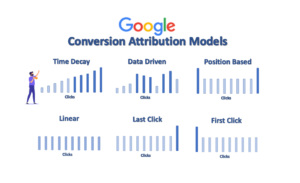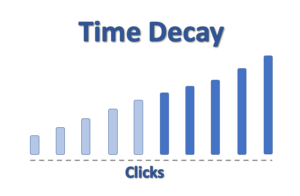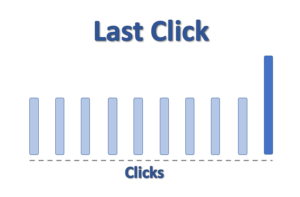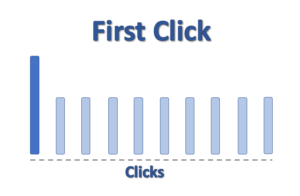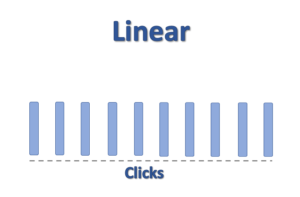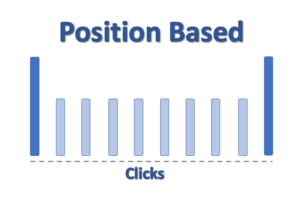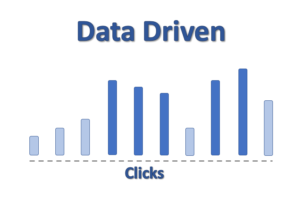Conversion Attribution Models in Google Ads

Table of contents
- There are several Conversion Attribution Models
- Think Football Team ‘Assists’ When Deciding on Your Conversion Attribution Model
- I have my favourite Conversion Attribution Model – and it is Time Decay!
- Football Not Your Thing? Not a Problem – Here is Conversion Attribution Models (with no Football Simile)
- Set Your Google Ads Account Up For Success
- There are Six Conversion Attribution Models in Google Ads – Here is the Top Level Information at a Glance!
- Want to Know More on the Six Conversion Attribution Models in Google Ads – Here is the Deeper Level Information and How Choosing Each Will Effect The Data in Your Google Ads Account!
- Time Decay Conversion Attribution Model
- Last Click Conversion Attribution Model
- First Click Conversion Attribution Model
- Linear Conversion Attribution Model
- Position-Based Conversion Attribution Model
- Data-Driven Conversion Attribution Model
- What’s Your Take on All of This? Did it Help?
Conversion Attribution Models – what is all the fuss about?
What is a Conversion Attribution Model? A Conversion Attribution Model in Google Ads is a rule, or even a set of rules, that establish and give credit for conversions and or sales. The different Conversion Attribution Models assign these conversions to touchpoints in the conversion path. For example, the First Interaction model in Google Ads assigns 100% credit to the very first touchpoint (e.g., click) that then lead to the conversion or sale.
Getting to grips with the idea of ‘Conversion Attribution Models’ and how they report data differently and how YOU can use that to your ADVANTAGE will almost definitely help you become a better digital marketer and heavily influence how well your account can perform moving forwards!
Why?
Let me explain!
There are several Conversion Attribution Models
Conversion attribution models allow you to assign (and then see in the Google Ads dashboard all the way down to the JUICY DETAILS such as Search Term, Location, Time of Day, Day of Week, What Ad Copy, The Page URL you sent them to, CTAs, Messaging and much more) for the conversion to one or more interactions (clicks) in the journey that the user took that ended in that conversion or sale. Why is that important? This is really important because not being able to see and give worth to some or all of the path will mean you are likely to end up cutting spend from areas of your account that are contributing to the conversion.
Think Football Team ‘Assists’ When Deciding on Your Conversion Attribution Model
If you’re into football think of it as ‘assists’ – meaning the different Conversion Attribution Models are ways of seeing who had the football in their possession on the run-up to scoring the goal (with the goal – you making the sale).
The player who scores the goal is GREAT and should get credit for it – right? But should they get all of the credit for the goal? What about the player or players who assisted the goal? Would the goal scorer have gotten the goal if they were out there on the pitch by themselves? Probably not right! The game of football is down to a combined effort between multiple players and the manager – and in this scenario – you are the ultimate Football Manager! So get ready to go pitchside and make every second of the match count in your favour!
Imagine your keywords are your team of football players – it can sometimes (more often than not) take several of these keywords (football players) to convince someone to convert (score the goal) and make the sale. Understating the different Conversion Attribution Models and how you can set these up so YOU can get the best data will mean you could win the Prem then on to the kind of stardom only the most successful Football Managers could ever dream of… Okay so maybe not quite so much glory – but trust me – it really does feel great to do an amazing job and be successful at what you do – right!
So – these Conversion Attribution Models allow you to see at the microscopic level – the players in your team that are doing GREAT FOR YOU and the players who are having lots of possession (spend) but not helping out the rest of the squad in winning matches and getting the all-important goals! You want GOAL SCORERS on your team but you also want to see who has been a part of SCORING THAT GOAL and Conversion Attribution Models allow you to do just that!
I have my favourite Conversion Attribution Model – and it is Time Decay!
My all-time favourite model is Time Decay – I will go into more detail below on the different types of Conversion Attribution Models, how they will report your data differently and how that can make or break your account in terms of ROAS (Return on Ad Spend)!
As a Pay Per Click marketing expert, you want to get the most exposure for your ads to the right people at the right time using as little budget as possible – right? And there’s no better way to do that than through using the right conversion attribution model if done correctly.
Football Not Your Thing? Not a Problem – Here is Conversion Attribution Models (with no Football Simile)
In my opinion, PPC advertising offers a highly accurate way to quantify the success of activity and spend when compared to other areas of marketing.
The answer won’t always be as simple as it seems. Even if a customer has converted after clicking on one of your ads from Google. Did you know that most accounts Pay Per Click spend doesn’t directly result in a sale or lead? Most accounts convert less than 10% of the traffic they pay for. This means that 90% of your budget ‘could be wasted’ – or at least that is what it can look like – this can all depend on the attribution type you are using.
Statistics shown by WordStream indicate the average conversion rate is only around 3.75% – this means £0.96 in every £1.00 spent on PPC marketing is not really doing the person or company spending it any good at all!
OR IS IT?
This is what we aim to help you understand here today! So buckle in and let’s take a walk through the mysterious and dark arts of conversion attribution models and why choosing the correct one for your business can mean amazing growth and predictive modelling. Or plateau after plateau with little understanding of why you can’t seem to get your account ‘Past GO’ – and collecting that proverbial ‘£100’ can seem very difficult indeed….
In most cases, your prospective customer might have clicked on various ads of yours and on several devices before they decide to buy from you. So how exactly can you pinpoint where the conversion came from?
Set Your Google Ads Account Up For Success
Mastering these attribution models will allow you to understand how your customers interacted with your site and help you delve deeper into their actions and interactions with your business before they made a purchase. Sounds handy, right?
It sounds great – because it is!
Understanding the importance and impacts of the different types of Conversion attribution models will help you reach new heights of success as using the correct one will give you valuable data to optimise around so you get the best results for your buyer journey.
Buyer journeys differ massively, for example, an Emergency Dentist’s buyer journey is likely to be very short – their customer is in pain and they are likely to want swift action. Whereas someone looking to purchase a luxury yacht is likely to want to see their options before committing. This is before we start to look at CTAs (calls to action) Offers and Many other tactics widely practised in today’s marketplace.
Your buyer journey will be unique to you and your offering so choose wisely! Read on for our advice on choosing the right model for you!
There are Six Conversion Attribution Models in Google Ads – Here is the Top Level Information at a Glance!
There are SIX main Conversion Attribution Models that are used in Google PPC to work out if it is worth it for your company. Ads, below will give you an idea of how you are able to divide the credit for every conversion you get. Let’s have a look at each of them.
- Time Decay Conversion Attribution Model
The Time Decay attribution model assigns the interactions closest in time to the sale to get most of the conversion.
- Last Click Conversion Attribution Model
The Last Interaction attribution model, gives all of the sales conversion to the very First interaction.
- First Click Conversion Attribution Model
The First Click Interaction attribution model, gives all of the sales conversion to the very First click.
- Linear Conversion Attribution Model
The Linear attribution model, each touchpoint in the conversion path gets the same portion (percentage) of the sale
- Position Based Conversion Attribution Model
With the Position Based attribution model, the sale is distributed between the clicks. 40% of the credit is assigned to the first and 40% to the last click, with the remaining 20% distributed evenly to the interactions between the first and last click.
- Data Driven Conversion Attribution Model
The Data Driven attribution model distributes credit for the sale based on your past data for this conversion action. It’s different from the other models, in that it uses your account’s data to calculate the actual contribution of each interaction across the conversion path. Note: This is only available to accounts with enough data.
Want to Know More on the Six Conversion Attribution Models in Google Ads – Here is the Deeper Level Information and How Choosing Each Will Effect The Data in Your Google Ads Account!
Time Decay Conversion Attribution Model
The time decay model is similar to the linear model but is a firm favourite of many digital marketing experts including us here at the PPC Geeks!
The difference is that in the time decay model, more credit is given to the click closest to the final conversion but assigns values to previous clicks that reduce depending on the time from when the conversion happened (did you get it? Read it again if it didn’t stick).
The Time Decay Conversion Attribution Model uses a 7-day half-life, meaning that a click 8 days prior to the conversion can only get half the credit compared to a click just a day before the conversion.
This model is perfect for many businesses as it allows you to weight clicks, spend and the conversion value to interactions closest to the last click – but still allow portions of the conversion value to the other interactions in the buying cycle. Perfect for those who want to figure out the best strategies for driving the most conversions while being as conservative as possible with the budget.
We here at the PPC Geeks often champion the Time Decay conversion attribution model as it allows us ‘at scale’ to optimise accounts for a higher return on ad spend by weighting the conversion values to the later clicks in the buying path.
All accounts are different and picking the correct conversion attribution model is not set in stone – so careful consideration and monitoring are always advised.
But if you want to aim for the stars and get your attribution model pointing for improvement we often recommend Time Decay as it takes into account the many touchpoints – but weighs slightly for the latter clicks.
Our verdict on Time Decay – we often champion this conversion attribution type as it is a great all-rounder of a conversion attribution model – highly recommended for scaling where matters the most in an account!
Last Click Conversion Attribution Model
This is pretty much the default setting and is still used by many of the accounts we audit.
Last click attribution gives 100% credit for any conversion to the very last-clicked ad as well as the keyword or network that triggered the ad.
For example, if a user clicks on 10 of your adverts and converted on the last click, then the other 9 clicks won’t get any credit for the conversion.
Any previous interactions won’t matter and you won’t be able to see any of this data in Google Ads, this is very dangerous from an optimisation perspective as you are highly likely (if you or your team are doing their jobs correctly) to cut ad spend away from what could be highly important steps in the buying decision making process. The question here is – would you have got the last click that got the conversion if you hadn’t had the first click (or any of the other 8 steps in the buying process between these two clicks)..
From an optimisation standpoint, this can have a hugely negative impact on your results. The reason being you’re likely to cut ad spending away from some or all of these important steps in the buying decision process because you can’t see that these clicks lead to a conversion.
The question here is: would you have the last click if the previous clicks weren’t made?
Our verdict on Last Click – do not use Last Click as there are better ways to display your data now!
First Click Conversion Attribution Model
Basically the complete opposite of the last click model. The first click model will give 100% credit for any conversion to the first-clicked ad and its trigger keyword or placement.
This model works best when you want to identify how new users were introduced to your brand. But we do not normally recommend this conversion type. It does not give you the visibility you need to optimise your account accurately.
We highly recommend you do not use the first click attribution model for conversion tracking. As you will not see the interaction points of the buyer journey.
Remember that you, your team and your businesses success is only as good as the data it can work with. First click in most cases does not allow you to have your eyes across the spectrum of the buyer journey.
In the scenario of 10 clicks leading to the sale – the first click model would assign all the conversion value to the very first click. So you would have no visibility on any of the interactions across the rest of the journey that ended in the sale.
Our verdict on First Click – do not use First Click as there are better ways to display your data now!
Linear Conversion Attribution Model
Do you wish you could understand how each of your ads played its part in the conversions you get? Then the linear model has you covered.
In a linear Conversion Attribution Model, you can expect equal credit distribution for all the clicks that led to a user’s conversion.
For example, if a user found your ad on the Search Network and visited your site, then one week later landed on your website through clicking one of your Retargeting Ads and makes a purchase then the credit will be distributed to both channels.
Through the linear model, you can see all touchpoints of your buyers’ journey. This is really helpful as it will allow you to push more sales data into every funnel you create and path your customers take. As the different touchpoints will be gaining equal credit for the conversion and conversion value.
Of course, it has its drawbacks. But if you want to know how to get better data to help you create conversion-focused accounts, then it’s definitely one of the places to start.
The linear model allows you to see all the touchpoints in your buyers’ journey. This is super helpful and will allow you to build out your Google Ads account to make smarter choices and help push more sales down funnels you create.
Constant testing and the evolution of your Google Ads Account will go hand in hand with a greater understanding of the many touchpoints users are taking when converting with your business.
The linear model (while it has some issues) is a great place to start when looking at how to get better data in your account. It will help when trying to craft conversion-focused accounts that simply help convert more clicks into customers. And allow you to optimise areas that are not providing ROI.
For example, if a user converts on your site and has interacted with 10 of your ads – each step in this path will get an even share of the conversion and value. Meaning each step in the journey will get 10% of a conversion and conversion value.
Whilst this Conversion Attribution Model is good there are possible Conversion Attribution Models that could work even better for your business.
Our verdict on Linear – we do not use Linear unless there is a standout reason for it as there are better ways to display your data! But this is dependent on the product, buyer journey, buyer cycle and what we are actively looking to achieve in any given situation or Google Ads account.
Position-Based Conversion Attribution Model
The Position Based Conversion Attribution Model focuses most of the conversion and value to the first and last click. It apportions out 20% across the other touch points your visitor took to convert.
When attribution types were made – they were not all made equal. And the position based Conversion Attribution Model is a prime example of this!
In this model, 40% of the credit is prioritised toward the first click while another 40% goes toward the last click. Meanwhile, the other 20% gets distributed evenly to the clicks in the middle.
In the 10 click scenario, this model would give 40% of the conversion to the first click and another 40% of the conversion to the last click with the other 8 interactions being given 2.5% each.
This Conversion Attribution Model could be used for very long buyer journeys. Ones where you want to heavily increase visitors at the top of the funnel and know where people convert. But are less interested in the many touchpoints in the middle.
Our verdict on Position Based – it has its value on some accounts but as a rule, it is not one we champion for most accounts. Most businesses would benefit more from having more of the value in the latter stages of the buying journey than this offers.
Data-Driven Conversion Attribution Model
The data-driven Conversion Attribution Model model works similarly to a position-based model, except that it uses Google’s algorithm as well as AI learning for weighing conversions.
It’s more of a scientific-based approach and will work best if you want to understand which channels drive the most conversions.
However, this one will depend on your individual conversion data, with more data showing better and more accurate results.
This is an option for most clients we speak to, but as we like to have the hard data. And make smart decisions that are in our clients best interests (Not Googles Best Interests). We often choose the Time Decay Conversion Attribution Model over this.
I am sure you understand that Google is very good at making money for itself. We prefer to have more control over improving results for our partners than this can sometimes offer.
Our verdict on Data Driven – we like to have as much control over the account as possible and make smart decisions on what will benefit our clients the most. Data Driven doesn’t always do this so we do not always recommend this. For most Google Ads accounts Time Decay will still prove more beneficial than this in my eyes.
What’s Your Take on All of This? Did it Help?
I hope you have found this interesting and insightful! It should at least have helped lift the lid on this area of Conversion Tracking for you. There is no one-size-fits-all solution for Attribution Models for your Google Ads account Conversion Tracking. It will mostly depend on your specific business model, goals as well as the channels and campaigns you have and want. And importantly where your account is today and where you want to get it to moving forwards.
This means you’ll need to pick the conversion attribution model that is in line with your needs.
It’ll mostly come down to figuring out which model works best for you by investigating the data within your account and working out what you want from your account in the future.
If you have any questions on Conversion Attribution Models in Google Ads reach out to us here at the PPC Geeks and we will be happy to provide you with a full and FREE Google Ads Audit to show you how you are doing in Google Ads and where we think you could cut wasted spend from your account while making more sales.
Author
Search Blog
Free PPC Audit
Subscribe to our Newsletter
The Voices of Our Success: Your Words, Our Pride
Don't just take our word for it. With over 100+ five-star reviews, we let our work-and our satisfied clients-speak for us.
"We have been working with PPC Geeks for around 6 months and have found Mark and the team to be very impressive. Having worked with a few companies in this and similar sectors, I rate PPC Geeks as the strongest I have come across. They have taken time to understand our business, our market and competitors and supported us to devise a strategy to generate business. I value the expertise Mark and his team provide and trust them to make the best recommendations for the long-term."
~ Just Go, Alasdair Anderson

